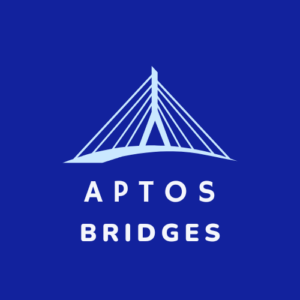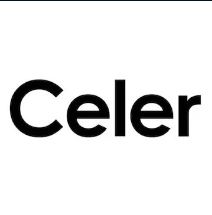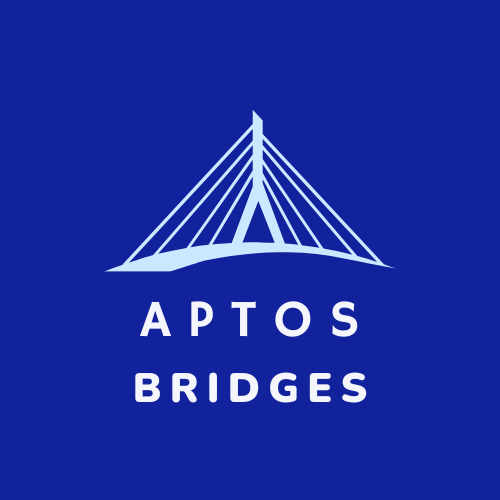Cryptocurrency bridges play a crucial role in enhancing blockchain interoperability by facilitating seamless token and data transfers between different networks. They address a significant challenge in the blockchain space – the lack of interoperability. Developers utilize these bridges to move tokens between blockchains, harnessing distinct platform advantages and promoting innovation and collaboration within blockchain communities. To maintain token value during transfers, bridges employ a mint-and-burn method. They come in various types, including federated and trustless bridges, each offering different levels of decentralization. Unidirectional bridges facilitate one-way asset movement, while bidirectional bridges enable asset conversion in both directions.

In this article we will look more into various bridges provided on the Aptos Ecosystem and their unique features in order to help you compare and make a choice.
What is Aptos Bridge?
Aptos Bridges, developed by LayerZero, represent a groundbreaking advancement in the domain of blockchain interoperability. These advanced bridges serve as crucial connectors, seamlessly facilitating the transfer of assets between Aptos and other prominent blockchains such as Ethereum, BNB Chain, and Polygon. Designed for user-friendliness and innovation, Aptos Bridges empower users to effortlessly transfer assets like ETH, USDC, and USDT to Aptos from various blockchain networks. Serving as a linchpin for asset transfers, these bridges usher in a new era in blockchain technology by emphasizing ease of use and connectivity across multiple networks. Their capacity to transcend conventional limitations makes Aptos Bridges pivotal in redefining the landscape of decentralized finance, providing a secure and efficient means for cross-chain transactions.
How to use Aptos Bridge?
Utilizing Aptos Bridges is a simple process that involves the following steps:
- Visit the official Aptos Bridge website: Initiate the procedure by accessing the designated Aptos Bridge website.
- Connect your source wallet: Choose the wallet from which you intend to transfer assets and specify your Aptos Wallet as the intended destination.
- Token selection and amount: Opt for the particular token you wish to bridge (such as ETH, WETH, USDC, or USDT) and specify the desired transfer amount.
- Network selection: Indicate the network from which you want to initiate the asset transfer.
- Transaction preview and execution: Review the transaction details and, upon confirmation, select ‘Send’ to execute the bridge.
Following these steps, the assets will seamlessly move to the Aptos network. The user-friendly interface is crafted for simplicity, providing prompts at each step of the process. It’s important to note that when interacting with an asset for the first time on Aptos, the platform mandates asset registration. Users will receive prompts concerning asset registration or claiming based on their prior interactions with the asset and the presence of APT in their wallet.
Top Aptos Bridges
1. LayerZero Bridge: Unlocking Web3 Interoperability

At the core of the LayerZero protocol lies the transformative LayerZero Bridge, a cornerstone technology poised to redefine Web3 interoperability. Its central mission is to seamlessly connect and foster communication across a multitude of over 50 diverse blockchains. This groundbreaking bridge transcends the limitations of individual blockchain networks, enabling the transfer of censorship-resistant messages and promoting collaborative interactions across an extensive array of ecosystems. In addressing this critical need within the blockchain space, LayerZero Bridge introduces a decentralized solution that champions inclusivity and interoperability on an unparalleled scale.
Key Features of LayerZero Bridge
- Interoperability: LayerZero Bridge facilitates smooth communication between blockchain networks, dismantling barriers and fostering seamless collaboration.
- Security and Efficiency: The protocol ensures security and efficiency by employing immutable on-chain endpoints, a configurable Security Stack, and permissionless Executors. This combination enhances the robustness of the system.
- Omnichain Development: LayerZero Bridge unifies semantics across supported blockchains, empowering developers to craft integrated omnichain applications. This feature paves the way for holistic blockchain solutions.
- Cross-Chain Messaging and Verification: To ensure secure cross-chain messaging and reliable verification, LayerZero Bridge utilizes an oracle and relayer. This enhances the trustworthiness of messages transferred between different blockchains.
- Supported Blockchains: LayerZero Bridge boasts broad compatibility, supporting various blockchains such as Aptos, Avalanche, Polygon, and Harmony. This inclusive approach allows for widespread adoption and interaction across diverse ecosystems.
2. Decoding Wormhole Bridge: Decentralized Blockchain Interoperability

Wormhole operates as a decentralized and universal message-passing protocol, purpose-built to seamlessly interconnect numerous blockchains. Serving as an open-source platform for blockchain development, it plays a crucial role in establishing connections within the decentralized web. Wormhole’s feature set enhances the efficiency of cross-chain communication and interaction. Notably, it boasts compatibility with more than 30 blockchains and has successfully facilitated the transfer of a substantial value exceeding $35 billion.
Key Features:
- Universal Messaging Protocol: Wormhole’s core functionality lies in its universal messaging protocol, facilitating secure cross-chain transfers of tokens and data.
- Wormhole Token Bridge: Trustless Transfers: The Wormhole Token Bridge enables trustless and permissionless transfers between major blockchains, including Ethereum, Solana, Binance Smart Chain, and others.
- Guardian-Secured Transactions: Guardians, represented by staking providers like Everstake, enhance the security of token transfers, ensuring a trustworthy protocol.
- Wide Blockchain Support: Wormhole stands out by supporting an extensive range of blockchains, granting users access to diverse DeFi protocols without reliance on centralization.
- NFT Bridging Across Chains: Wormhole introduces an NFT portal, allowing users to bridge Non-Fungible Tokens (NFTs) across different blockchains, adding a layer of versatility.
- Native DApp Support: Wormhole supports decentralized applications natively, empowering developers to optimize functionality across different blockchains.
3. Celer’s cBridge: Transforming Multi-Chain Interoperability
Celer’s cBridge, unveiled in July 2021, represents a groundbreaking multi-chain interoperability platform, providing swift, cost-efficient, and secure asset and message bridging across 15+ diverse chains. Rooted in decentralization, Celer aspires to propel blockchain adoption into the mainstream, rapidly gaining prominence as a leading bridging solution in the ecosystem.

Key Features:
- Asset and Message Bridging: cBridge enables rapid and secure bridging of assets and arbitrary messages, fostering seamless communication across a diverse range of chains.
- Inter-chain Message Framework: Beyond asset bridging, Celer introduces the Inter-chain Message Framework, enabling general message passing and smart contract calls across different chains. This framework optimizes liquidity utilization, application logic coherence, and shared states for inter-chain-native dApps.
- Use Cases: The Inter-chain Message Framework supports various use cases, including DEXes, yield aggregators, lending protocols, DAO governance protocols, NFT marketplaces, and metaverse games. This broad applicability showcases the versatility of cBridge in catering to diverse blockchain scenarios.
- Total Value Locked (TVL): cBridge boasts robust user confidence, evident in its impressive Total Value Locked (TVL) metrics. The TVL graph reflects a continuous rise, reaching $2.2 billion in transactions, underscoring the platform’s reliability and user trust.
4. Meson Bridge: Revolutionizing Cross-Chain Transactions

Drawing inspiration from quantum mechanics, the Meson Bridge, much like meson particles, acts as a bridge between different blockchains. In quantum physics, mesons transmit attractive interactions between protons and neutrons, fostering a connection between them. Similarly, the Meson Bridge enriches possibilities by connecting diverse blockchains, contributing to the development of a thriving application ecosystem. Building upon existing cross-chain bridge technical solutions, the Meson Bridge strives to offer users a more convenient, faster, cost-effective, and secure means of conducting cross-chain swaps.
Key Features:
- Stablecoin Focus: Meson prioritizes stability, concentrating on stablecoins and selected tokens. This strategic focus allows for optimization, maximizing user experience in cross-chain transactions.
- Swift Transaction Speed: Users can expect swift transaction speeds on Meson, with exchanges typically completing in 1-2 minutes. This rapid execution enhances the efficiency of cross-chain swaps.
- Cost Optimization: A meticulous approach to protocol design and contract implementation enables Meson to minimize costs for users. This optimization contributes to a more cost-effective cross-chain transaction environment.
- Direct Exchange Capability: Meson utilizes widely accepted tokens on each chain directly, facilitating direct cross-chain exchanges between tokens of the same value. This feature is particularly evident in pairs like USDT ↔ USDC.
- Extensive Network Support: The Meson Bridge supports cross-chain swaps between 20+ stablecoins on 14+ EVMs & non-EVMs chains and layer 2 networks. This broad support ensures versatility and accessibility for users across various blockchain ecosystems.
- Security Assurance: Meson Protocol employs independent verification for each transaction, ensuring that participants have complete control over their funds. The protocol has undergone meticulous auditing by Trail of Bits, a leading security firm, underscoring its commitment to the highest security standards.
5. Mover Bridge: Facilitating Seamless Cross-Chain Connectivity
Mover Bridge heralds a transformative era in the blockchain domain, offering a decentralized, permissionless, and trustless network of nodes. Its primary function is to facilitate cross-chain transactions, enabling users to lock assets on one blockchain and effortlessly swap them for assets on another. Additionally, Mover innovates by minting one-to-one pegged representations of assets, expanding its utility across various blockchain ecosystems.

Key Features:
- Decentralized Network: Mover functions as a decentralized, permissionless, and trustless network, guaranteeing the security and autonomy of users’ assets.
- Hybrid Architecture: The hybrid architecture seamlessly integrates light client verification and MPC nodes, optimizing security and facilitating the swift addition of new blockchains.
- Efficient Cross-Chain Messaging: Mover utilizes a light client for EVM blockchains, streamlining secure cross-chain messaging for optimal performance.
- Proactive Security Measures: The implementation of a fully-automated monitoring and reconciliation service underscores Mover’s commitment to proactive security, automatically pausing transactions in case of suspicious activity.
- Community Governance: Mover prioritizes community engagement by distributing MPC nodes among core developers, community members, and Aptos ecosystem stakeholders, ensuring a decentralized and inclusive decision-making process.
6. ChangeNOW: Revolutionizing Cross-Chain Exchange and Liquidity Aggregation

ChangeNOW is a dynamic force in the cryptocurrency space, offering an innovative cross-chain exchange and liquidity aggregation platform that supports over 900 cryptocurrencies, including its native APT token. The platform provides users with a versatile ecosystem for seamless asset swapping and management. In addition to catering to individual users, ChangeNOW presents various Business-to-Business (B2B) solutions, such as API, widgets, white-label exchange services, and the groundbreaking ChangeNOW Bridge.
Key Features:
- Multichain Bridge: ChangeNOW introduces a Multichain Bridge service that enables users to pool together two or more assets, enhancing liquidity and accessibility for the supported assets across over 3000 ChangeNOW partners and millions of users.
- Self-listing without Centralized Exchanges (CEXes): ChangeNOW distinguishes itself by allowing users to self-list their assets without relying on centralized exchanges. With support for over 850 coins, users can provide liquidity and self-list their assets for swaps, fostering a decentralized and inclusive trading environment.
- Advanced Security: Security is paramount for ChangeNOW, with users retaining exclusive control over their liquidity. The platform employs a robust security infrastructure, utilizing both hot and cold storage mechanisms to ensure maximum protection for user funds.
- Flexible Bridge Settings: ChangeNOW Bridge offers unprecedented flexibility, allowing users to choose between a one-way or a two-way bridge. Users can customize exchange rates according to their preferences, and the platform provides options for managing network fee costs, whether borne by the liquidity owner or the customers.
Conclusion: The Interconnected Future of Blockchain
Each bridge, from the LayerZero Bridge unlocking Web3 interoperability to the innovative Meson Bridge drawing inspiration from quantum mechanics, plays a crucial role in fostering seamless cross-chain transactions. The decentralized and trustless nature of bridges like Mover and ChangeNOW reflects a commitment to security and autonomy for users.
The integration of Aptos Bridges marks a paradigm shift in blockchain technology, emphasizing user-friendly experiences and connectivity across multiple networks. As the blockchain space evolves, these bridges stand as vital connectors, promoting collaboration and innovation within decentralized communities.
Princy Agarwal, a postgraduate in English from Delhi University, writes content for Tricky Finance, where they simplify complex financial topics for readers. With a knack for clear communication, Princy’s work helps make finance understandable and accessible to all.




